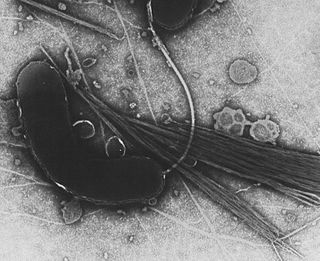
The Vibrionaceae are a family of Pseudomonadota given their own order, Vibrionales. Inhabitants of fresh or salt water, several species are pathogenic, including the type species Vibrio cholerae, which is the agent responsible for cholera. Most bioluminescent bacteria belong to this family, and are typically found as symbionts of deep-sea animals.
Acidomonas is a genus in the phylum Pseudomonadota (Bacteria). The genus contains single species, namely A. methanolica, formerly known as Acetobacter methanolicus
Actinoalloteichus is a genus in the phylum Actinomycetota (Bacteria).
Actinocorallia is a genus in the phylum Actinomycetota (Bacteria).
Actinokineospora is a genus in the phylum Actinomycetota (Bacteria).
Actinomycetospora is a genus in the phylum Actinomycetota (Bacteria).
Aeribacillus is a genus in the phylum Bacillota (Bacteria).
Daeguia is a genus in the phylum Pseudomonadota (Bacteria).
Deefgea is a genus of bacteria in the phylum Pseudomonadota. Deefgea are described as Gram-negative, rod-shaped, facultative anaerobes which generally occur singly. Deefgea are motile, either by a single flagellum or two polar flagella. They are both catalase and oxidase positive.
Dendrosporobacter is a genus in the phylum Bacillota (Bacteria). Members of the class Negativicutes, stain gram negative, despite being firmicutes
Agarivorans is a genus in the phylum Pseudomonadota (Bacteria).
Agreia is a genus in the phylum Actinomycetota (Bacteria).
Agromyces is a genus in the phylum Actinomycetota (Bacteria).
Aidingimonas is a genus in the phylum Pseudomonadota (Bacteria).
Aliagarivorans is a genus in the phylum Pseudomonadota (Bacteria).
Alishewanella is a genus in the phylum Pseudomonadota (bacteria).
Alkalibacillus is a genus in the phylum Bacillota (Bacteria).
Cryomorpha is a genus in the phylum Bacteroidota (Bacteria).
Marichromatium is a genus in the phylum Pseudomonadota (Bacteria). The name Marichromatium derives from: Latin mare, the sea; Neo-Latin Chromatium, a genus name; to give Marichromatium, the Chromatium of the sea, the truly marine Chromatium.

